Shore leave: Bad weather? Off to the museum!

The Ozeaneum in Stralsund, for example, which opened in 2008, has long since become a crowd-puller. With its extravagant architecture in the middle of the historic buildings on the harbour, it is an eye-catcher from the outside alone. The white exterior façade made of ship steel forms a striking break in the romantic harbour panorama of the Unesco World Heritage city.
Baltic Sea, North Sea and Atlantic theme worlds
It has attracted around eight million visitors to date and was even named "Europe's Museum of the Year" in 2010. And quite rightly so. 50 seawater aquariums, some of them huge, provide impressive insights into the underwater landscapes of the northern seas. In the themed worlds "Baltic Sea", "North Sea" and "Open Atlantic" as well as in the penguin tank on the roof, the animals can be observed in elaborately constructed and authentic-looking habitats.
The discovery tour in the Baltic Sea aquariums begins with the Stralsund harbour basin and leads across the Bodden waters past the chalk coast of Rügen to the archipelago of Scandinavia. The Baltic Sea exhibition alone is considered the largest of its kind in Europe. In the North Sea basins, a tunnel aquarium is dedicated to Heligoland, Germany's only high seas island, while sharks and rays circle a shipwreck in the largest basin of the Atlantic exhibition. This wreck is a detailed replica of a cargo ship that ran aground off Namibia in 1909.
Penguins above the rooftops of the city
The aquariums, in which over four million litres of seawater circulate, are joined by numerous animal and plant exhibits created by the in-house taxidermy department. On the roof terrace of the Ozeaneum is another major attraction that could raise the question of species-appropriate husbandry, especially in summer: Humboldt penguins frolic here in a rock and water landscape with the best view of Stralsund's old town. But unlike Antarctic emperor penguins, for example, they are used to warm land temperatures, provided they can dive into cold water. They are also threatened with extinction, which is why breeding helps to preserve the species.
Songs of the humpback whales
The museum experience is rounded off with the giants of the seas: various sea giants hang from the ceiling in lifelike size and impressively illuminated. These include a 26 metre long blue whale and a diving sperm whale in a clinch with a giant squid. Humpback whale songs and the clicking sounds of hunting sperm whales perfect the unique atmosphere, which can also be enjoyed while lying down. In addition to changing photo exhibitions, there is a well-stocked museum shop offering a wide range of gift ideas for young and old, as well as a restaurant with a beautiful view of the harbour island.
To avoid spending too much time in the wet in the queue at the entrance, the Ozeaneum currently advises visitors to arrive after 4 pm. The museum is open until 7 pm. And to purchase an online ticket in advance. The nearby maritime museum in Stralsund's old town is also recommended as an equally worthwhile alternative.
Museum tips for the whole of Germany
If you are travelling somewhere else on the German coast or on a local inland waterway with your ship - or are stuck in the harbour due to the bad weather - you will usually also find exhibitions or other attractions with a maritime theme nearby. We have put together almost 50 addresses, from Sylt to Munich, that are definitely worth a visit and will quickly make you forget the rainy day.

